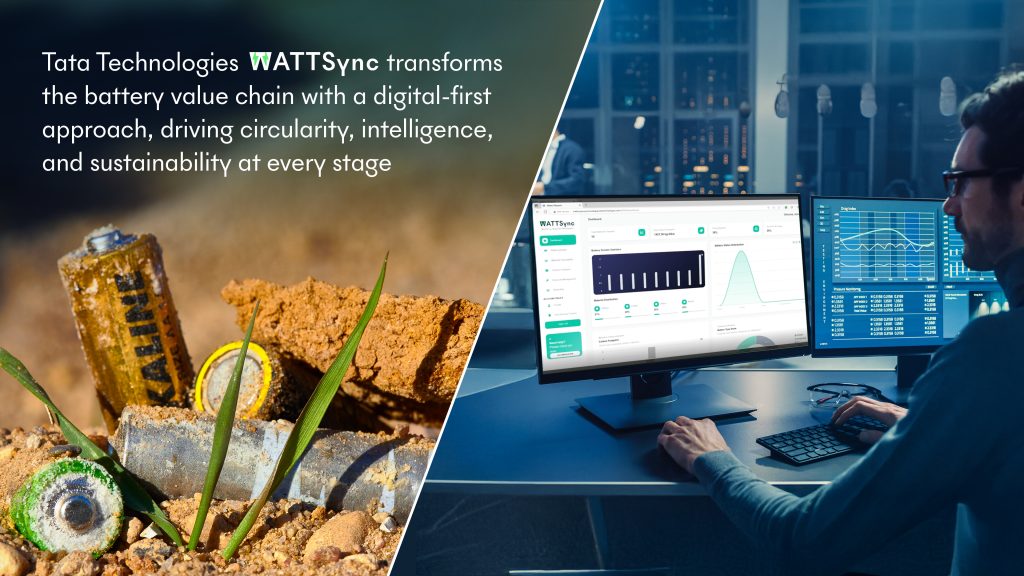In an era where clean mobility is no longer a choice but a global imperative, the question is no longer whether electric vehicles will dominate, but how the industry will ensure their sustainability, safety, and long-term value. Batteries—the beating heart of electric mobility—carry with them a complex web of challenges, from ethical sourcing and carbon footprint accountability to regulatory compliance and lifecycle traceability. As nations across Europe, the US, China, and India converge on stringent battery passport mandates, the race is on for solutions that go beyond compliance to unlock resilience, trust, and innovation.
It was against this backdrop that Shweta, Sub-Editor of The Battery Magazine, had the opportunity to engage in an in-depth conversation with Mr. Marc Manns, Vehicle Line Director – EE, Tata Technologies. In this exclusive interview, Mr. Manns shed light on WattSync, Tata Technologies’ pioneering blockchain-enabled EV battery passport platform. He highlighted how WattSync is shaping the future of compliance and sustainability, the synergy between engineering and digital expertise, the global R&D effort behind its creation, and its potential to drive circular economy business models.
Let’s delve into the conversation to uncover how Tata Technologies is not just engineering solutions—but engineering a better, sustainable future.
- Could you begin by introducing Tata Technologies and telling us about the recently launched WattSync—your blockchain-enabled EV battery passport platform? How is it positioned to address evolving global battery compliance and sustainability needs?
Tata Technologies is a global product engineering and digital services company, and our purpose is to engineer a better world by helping our customers build sustainable and future-ready products. WattSync, our newly launched digital battery passport solution, is built to address one of the most pressing challenges in the mobility sector: compliance with evolving global battery regulations while enabling transparency and sustainability across the battery lifecycle. It is blockchain-enabled, cloud-based, and API-driven, offering cradle-to-grave traceability from mining to recycling. With regulatory timelines in the EU, US, China, and India converging toward 2027–2029, WattSync is not just as a compliance tool but as a platform that unlocks long-term value through ethical sourcing, carbon footprint tracking, and lifecycle intelligence.
- Tata Technologies emphasizes synergy between engineering and digital expertise. How have these cross-disciplinary strengths shaped the development of WattSync, particularly in meeting the technical rigors of global battery passport requirements?
The uniqueness of Tata Technologies lies in the way we combine 30+ years of deep automotive and electrification engineering experience with strong capabilities in digital technologies, cybersecurity, and enterprise IT. WattSync is developed by leveraging this cross-disciplinary strength. Our engineering teams understand the technical depth of EV powertrains, battery management systems, and lifecycle performance, while our digital teams bring expertise in data modeling, AI/ML, and secure system integration. This synergy allowed us to design WattSync with a data framework that is both regulation-ready and future-proof, while also ensuring it integrates seamlessly with PLM, MES, ERP, and on-vehicle systems. That balance between engineering reality and digital innovation is what enables WattSync to meet the global compliance bar without creating operational disruptions.

- WattSync integrates blockchain, AI, and ML to deliver cradle-to-grave battery traceability. Could you walk us through the R&D journey—especially the collaboration across your teams in India, UK, Sweden, and China?
WattSync’s R&D journey reflects the global nature of the challenge we’re solving. Our teams in India led the architecture and development of the cloud-native, API-first platform, ensuring it can scale and integrate with existing enterprise systems. Our UK team, drawing on its engagement with European OEMs, focused on aligning the data schema with EU Battery Regulation requirements. Our Swedish colleagues contributed expertise around cybersecurity and data governance, particularly for interoperability with OEM data lakes. Meanwhile, our team in China brought insights into supply chain complexities, especially around raw materials. Together, this collaboration helped us create a solution that is both globally standardized and locally adaptable as well as capable of meeting regulatory nuances while serving as a unified platform across geographies.
- With the EU, US, China, and India introducing battery passport mandates by 2027–2029, how does WattSync help OEMs not only achieve compliance but also gain strategic insights into supply chain transparency, carbon footprint tracking, and operational efficiencies?
Compliance is only the starting point. WattSync automates regulatory reporting, creating immutable, audit-ready records to ensure OEMs stay ahead of evolving mandates. But beyond compliance, it enables OEMs to gain real-time insights into supply chain traceability, greenhouse gas emissions, and material recovery rates. By unifying static data (design, sourcing) with dynamic data (usage, health, recycling), WattSync provides dashboards and analytics that highlight carbon hotspots, optimize sourcing strategies, and inform warranty and service planning. This turns regulatory data into actionable intelligence, helping OEMs enhance supply chain resilience, reduce costs, and differentiate themselves in a market that increasingly values sustainability.
- WattSync leverages AI-driven prognostics to detect and predict potential issues such as thermal runaway and battery faults. How do these predictive and preventive capabilities enhance safety, reliability, and warranty optimization for OEMs?
AI-driven prognostics is a key differentiator in WattSync. By capturing in-use battery data and running ML models trained on large datasets, the platform can detect anomalies and predict potential issues like thermal runaway, degradation, or voltage imbalance before they escalate. For OEMs, this capability enhances safety by enabling early interventions, improves reliability by minimizing downtime, and optimizes warranty management by identifying patterns that drive failures and costs. It allows OEMs to proactively support customers, reduce warranty claims, and extend battery life – all while meeting regulatory requirements for reporting state-of-health and performance.

- Ethical sourcing and sustainability are critical for EV batteries. How does WattSync extend transparency to raw materials like nickel, cobalt, and manganese—ensuring traceability while aligning with carbon footprint reduction goals?
WattSync tracks the journey of raw materials like nickel, cobalt, manganese, and lithium from their source through refining, cell manufacturing, and pack assembly. By using blockchain-enabled traceability, it ensures that once recorded, the data cannot be altered, giving OEMs confidence in provenance claims. The platform also integrates carbon footprint metrics into its traceability records, enabling OEMs to measure and disclose the environmental impact of sourcing choices. This dual focus on ethical sourcing and carbon reduction supports compliance with due diligence directives while helping OEMs build trust with regulators, investors, and consumers who are increasingly demanding sustainable and responsible supply chains.
- India is a uniquely price-sensitive EV market. How are you tailoring WattSync’s design—both in terms of data models and cost structures—to ensure accessibility and adoption by domestic OEMs?
We recognize that adoption in India must balance regulatory readiness with cost sensitivity. WattSync has been designed with modularity in mind. OEMs can start with compliance essentials and then scale up to advanced analytics and prognostics as their needs evolve. On the cost side, the SaaS model allows flexible deployment, reducing upfront investment while giving OEMs control over hosting. Importantly, the platform has been piloted with domestic pack manufacturers, ensuring that the data models reflect the practical realities of local supply chains. This approach makes WattSync accessible while still offering the sophistication needed to stay globally competitive.
- Looking ahead, how do you envision WattSync evolving to support circular economy initiatives—such as second-life battery applications, recycling traceability, or even enabling new business models like battery-as-a-service or data monetization?
WattSync was architected with the circular economy in mind. The platform doesn’t stop at end-of-life—it extends traceability into second-life use cases, recycling, and material recovery. For OEMs and recyclers, this means they can track not just compliance but also the economic value of recovered materials, feeding insights back into design and sourcing strategies. Looking ahead, WattSync can serve as the backbone for new business models like battery-as-a-service, where accurate state-of-health data underpins usage-based contracts, or even for data monetization, where anonymized lifecycle data supports ecosystem-wide innovation. In that sense, WattSync is not just a compliance tool, but a platform for enabling the business models of the future mobility ecosystem.



